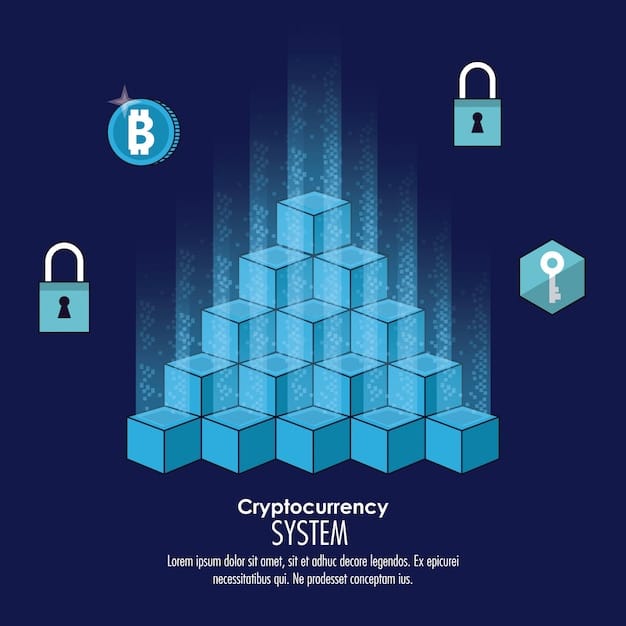Altcoin Scalability: Layer-2 Solutions for Ethereum’s Congestion

Altcoin scalability solutions like Layer-2 technologies, including rollups, sidechains, and state channels, are critical for addressing Ethereum’s congestion issues by processing transactions off-chain, thereby increasing transaction throughput and reducing gas fees.
Ethereum’s popularity has led to network congestion and high gas fees, hindering its widespread adoption. Altcoin scalability solutions, particularly Layer-2 technologies, offer a promising path to alleviate these issues. Let’s explore how these technologies are revolutionizing the Ethereum ecosystem.
Understanding Ethereum’s Scalability Problem
Ethereum, while a pioneering blockchain platform, faces significant scalability challenges. As the number of users and applications on Ethereum grows, the network struggles to handle the increasing transaction volume, leading to congestion and high fees. This section delves into the root causes of Ethereum’s scalability problem and its impact on the network.
The Blockchain Trilemma
The Blockchain Trilemma is a concept that highlights the inherent challenges in achieving scalability, security, and decentralization simultaneously. Ethereum, like many other blockchains, strives to balance these three properties, but optimizing for one often comes at the expense of others.
- Scalability: The ability of a blockchain to handle a large volume of transactions efficiently.
- Security: Ensuring the network is resistant to attacks and malicious activities.
- Decentralization: Distributing control and decision-making power across the network to prevent censorship and single points of failure.
Impact of Congestion and High Fees
Ethereum’s congestion and high gas fees have created several challenges for users and developers. Transactions can take a long time to confirm, and the cost of interacting with decentralized applications (dApps) can be prohibitively expensive. This has led to a search for solutions that can improve Ethereum’s scalability without compromising its security or decentralization.
The high cost of gas fees discourages many users from participating in the Ethereum ecosystem. Simple transactions can cost several dollars, and more complex interactions with dApps can cost even more. This has limited the accessibility of Ethereum to a smaller group of users and hinders its potential for widespread adoption.

Introduction to Layer-2 Scaling Solutions
Layer-2 scaling solutions offer a way to address Ethereum’s scalability issues without altering the base layer (Layer-1) of the blockchain. By processing transactions off-chain and only submitting finalized results to the main chain, Layer-2 technologies can significantly increase transaction throughput and reduce gas fees. This section provides an overview of the different types of Layer-2 solutions.
Rollups: Optimistic and ZK-Rollups
Rollups are a type of Layer-2 scaling solution that bundles multiple transactions into a single batch and submits them to the Ethereum main chain. There are two main types of rollups: Optimistic Rollups and ZK-Rollups.
- Optimistic Rollups: Assume transactions are valid unless proven otherwise. They allow a challenge period where anyone can dispute the validity of a transaction.
- ZK-Rollups: Use zero-knowledge proofs to verify the validity of transactions. This eliminates the need for a challenge period, resulting in faster transaction confirmation times.
- Benefits: Rollups offer significant improvements in transaction throughput and reduced gas fees compared to transacting directly on the Ethereum main chain.
Sidechains: Independent Blockchains
Sidechains are independent blockchains that run in parallel with the Ethereum main chain. They have their own consensus mechanisms and can be optimized for specific use cases. Sidechains can communicate with the Ethereum main chain through bridges, allowing users to transfer assets between the two chains.
Sidechains offer greater flexibility in terms of consensus mechanisms and block sizes compared to the Ethereum main chain. However, they also introduce additional trust assumptions, as they are typically controlled by a smaller group of validators.

Popular Layer-2 Projects on Ethereum
Several Layer-2 projects are actively working to improve Ethereum’s scalability. These projects employ different technologies and strategies to achieve their goals. This section highlights some of the most popular Layer-2 projects and their contributions to the Ethereum ecosystem.
Polygon (Matic): A Multi-Chain System
Polygon (formerly Matic Network) is a Layer-2 scaling solution that aims to provide a multi-chain system on top of Ethereum. It supports multiple scaling solutions, including Plasma, Optimistic Rollups, and ZK-Rollups. Polygon’s goal is to create a platform where developers can easily deploy and scale their dApps.
Arbitrum: Optimistic Rollup Solution
Arbitrum is an Optimistic Rollup solution that aims to provide a scalable and secure environment for dApps. It uses a unique dispute resolution mechanism that allows for efficient and cost-effective verification of transactions. Arbitrum is compatible with existing Ethereum smart contracts, making it easy for developers to migrate their applications.
Arbitrum’s Optimistic Rollup approach enables high transaction throughput and low gas fees compared to the Ethereum main chain. Its compatibility with existing Ethereum tooling and infrastructure makes it a popular choice for developers looking to scale their dApps.
Optimism: Another Optimistic Rollup
Optimism is another Optimistic Rollup solution that is focused on providing a simple and developer-friendly environment for scaling Ethereum dApps. It uses a single-round fault proof mechanism, which simplifies the process of verifying transactions and reduces the risk of fraudulent activity.
Security Considerations for Layer-2 Solutions
While Layer-2 solutions offer significant benefits in terms of scalability and cost reduction, it is important to consider the security implications of these technologies. Different Layer-2 solutions have different security models and trade-offs. This section explores the security considerations for Layer-2 solutions.
Trust Assumptions and Vulnerabilities
Layer-2 solutions often introduce additional trust assumptions compared to transacting directly on the Ethereum main chain. For example, sidechains may rely on a smaller group of validators to secure the network, which could make them more vulnerable to attacks.
Economic Incentives and Governance
The economic incentives of Layer-2 solutions play a crucial role in their security. Validators and operators of Layer-2 networks must be incentivized to act honestly and in the best interests of the network. Proper governance mechanisms are also essential for ensuring the long-term security and stability of Layer-2 solutions.
Many Layer-2 projects have implemented decentralized governance mechanisms that allow token holders to participate in decision-making processes. This helps to ensure that the network is aligned with the interests of its users and that changes are made in a transparent and accountable manner.
Future Trends in Ethereum Scalability
The development of Ethereum scalability solutions is an ongoing process. New technologies and approaches are constantly being explored. This section looks at some of the future trends in Ethereum scalability.
Data Availability Solutions
Data availability is a critical component of Layer-2 scaling solutions. It refers to the ability of users to access the transaction data necessary to verify the validity of transactions. Several projects are working on data availability solutions that can further improve the scalability and security of Layer-2 networks.
- Validium: A type of Layer-2 scaling solution that uses off-chain data availability.
- Volition: Allows users to choose between on-chain and off-chain data availability.
Sharding: Layer-1 Improvement
Sharding is a Layer-1 scaling solution that involves dividing the Ethereum blockchain into multiple shards, each of which can process transactions independently. This would significantly increase the overall transaction throughput of the Ethereum network. Sharding is a complex and ambitious project that is still under development, but it has the potential to dramatically improve Ethereum’s scalability.
Sharding would allow Ethereum to process transactions in parallel, rather than sequentially. This would significantly increase the network’s capacity and reduce congestion. However, sharding also introduces new challenges related to cross-shard communication and data consistency.
Conclusion
Ethereum’s scalability challenges are being addressed by a variety of innovative Layer-2 technologies. Rollups, sidechains, and other scaling solutions offer promising paths to increase transaction throughput, reduce fees, and improve the overall user experience. As these technologies continue to evolve, Ethereum is poised to become a more scalable and accessible platform for decentralized applications.
| Key Point | Brief Description |
|---|---|
| 🚀 Layer-2 Scaling | Solutions that improve Ethereum’s scalability by processing transactions off-chain. |
| 🛡️ Security Aspects | Layer-2 solutions introduce different trust assumptions that require careful consideration. |
| 💰 Rollups | Aggregate transactions into batches for increased throughput and lower gas fees. |
| ⛓️ Sidechains | Independent blockchains running parallel to Ethereum that offer flexibility in consensus mechanisms. |
Frequently Asked Questions
▼
Layer-2 scaling solutions are technologies that improve Ethereum’s scalability by processing transactions off-chain while still benefiting from Ethereum’s security. They aim to reduce congestion and lower gas fees on the main network.
▼
Rollups aggregate multiple transactions into a single batch, which is then submitted to the Ethereum main chain. This reduces the amount of data and computation required on the main chain, increasing transaction throughput.
▼
Optimistic Rollups assume transactions are valid unless proven otherwise, while ZK-Rollups use zero-knowledge proofs to verify transaction validity. ZK-Rollups offer faster confirmation times due to not needing a dispute period.
▼
While they enhance scalability, Layer-2 solutions introduce different trust assumptions compared to transacting directly on Ethereum. It’s important to assess the specific security models and trade-offs of each solution.
▼
Some popular Layer-2 projects include Polygon (Matic), Arbitrum, and Optimism. These projects offer different approaches to scaling Ethereum and have gained significant traction in the Ethereum community.
Conclusion
In conclusion, the quest to scale Ethereum efficiently is ongoing, with Layer-2 solutions leading the charge. By understanding the mechanics of rollups, sidechains, and the security considerations involved, we can better navigate the evolving landscape of Ethereum scalability and its impact on the broader blockchain ecosystem.





